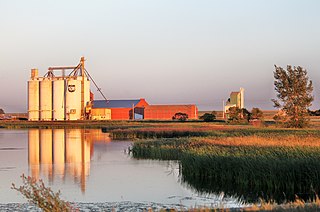
Sir Alexander Tilloch Galt, was a politician and a father of the Canadian Confederation.

Magrath is a town in Cardston County, Alberta, Canada. Its population was 2,481 in 2021. Magrath is 32 km (20 mi) south of Lethbridge and 242 km (150 mi) south of Calgary.

Cardston is a town in Alberta, Canada. It was first settled in 1887 by members of the Church of Jesus Christ of Latter-day Saints who travelled from Utah, via the Macleod-Benton Trail, to present-day Alberta in one of the century's last wagon migrations. The founder of the town was Charles Ora Card. The combined church and school was completed by January 29 the year following their arrival.

The Mormon corridor refers to the areas of western North America that were settled between 1850 and approximately 1890 by members of the Church of Jesus Christ of Latter-day Saints, who are commonly called "Mormons".

Stirling is a village in southern Alberta, Canada that is surrounded by the County of Warner No. 5. The village is located on Highway 4, approximately 31 km (19 mi) southeast of Lethbridge and 72 km (45 mi) northwest of the Canada–US border.

Charles Ora Card was the American founder of Cardston, Alberta, the first Mormon settlement in Canada. He has been referred to as "Canada's Brigham Young". Card was a Mormon pioneer as a teenager, traveling from the eastern United States to Utah Territory in the 1850s. After arriving in Utah, he supervised the construction of the Logan Utah Temple, served as a city councilman, and was appointed to the first board of trustees of Brigham Young College. Card was then tasked by leaders in the LDS Church to travel north to Canada and establish a Latter-day Saint colony there. He worked to make the community self-sufficient, participating in irrigation projects. Card was a practitioner of plural marriage, marrying a total of four wives and having sixteen children. He served in leadership positions within the LDS Church, mainly as stake president. He was the spiritual and economic leader of Cardston.

Raymond is a town in southern Alberta, Canada that is surrounded by the County of Warner No. 5. It is south of Lethbridge at the junction of Highway 52 and Highway 845. Raymond is known for its annual rodeo during the first week of July and the large population of members of the Church of Jesus Christ of Latter-day Saints. Raymond is also significant for its connection to the history of the Japanese experience in Alberta. The town has a rich history in high school sports, basketball, Canadian football, Judo and women's rugby. Raymond was recently mentioned as one of the first communities in Alberta to become a net-zero solar-powered community, after having installed solar panels on most town buildings.

Alberta Provincial Highway No. 5, commonly referred to as Highway 5, is a 129-kilometre (80 mi) highway that connects Lethbridge to Waterton Lakes National Park in southern Alberta, Canada. It begins as an east–west highway in Waterton and transitions to a north–south route before ending at Crowsnest Trail (Highway 3) in Lethbridge.
Warner is a village in Alberta, Canada. It is surrounded by the County of Warner No. 5, approximately 65 km (40 mi) south of Lethbridge. Warner is a farming community. Warner is situated at the intersection of Highway 4 and Highway 36, about 38 km north of the Montana border and Interstate 15. Warner's nearest neighbours are the towns of Stirling and Milk River.
The North Western Coal and Navigation Company, also known as Alberta Railway and Coal Company or Alberta Railway and Irrigation Company, was a coal mining company formed in London, England in 1882 by Sir Alexander Tilloch Galt, one of Canada's Fathers of Confederation. As part of his vision for Canada, Galt was committed to finding industries that would bring settlers to the District of Alberta of the Northwest Territories. The company was founded to create a coal mining industry that could bring settlers to the Northwest Territories. It was based in Lethbridge, Alberta, with his son Elliott Torrance Galt, managing day-to-day operations. The company's superintendent was William Stafford. Money for this company came from a consortium of investors from Canada, England, and the United States.

Since its organization in New York in 1830, The Church of Jesus Christ of Latter-day Saints has had a presence in Canada. The church's first missionaries to preach outside of the United States preached in Upper Canada; the first stake to be established outside of the U.S. was the Alberta Stake; and the Cardston Alberta Temple was the first church temple built outside of the boundaries of the United States.

Stirling Agricultural Village was designated as a National Historic Site of Canada on June 22, 1989. The site was designated as a national historical site of Canada because it is the best surviving example of a Mormon agricultural village. The Michelsen Farmstead was the focus of the community, and is now a totally restored museum, listed as a Provincial Historic Site in 2001. The Galt Historic Railway Park is another popular museum located in this historic site.

Johann Theodore Brandley was a Mormon missionary and colonizer of the agricultural village of Stirling, Alberta, Canada.
Conrad is a former unincorporated community in the County of Warner No. 5, Alberta, Canada. The population of the community was fairly small and only had around 5 people with two grain elevators. Today nothing remains of the community, but its original location on the historic Red Coat Trail was 8 km (4 mi) east of the Hamlet of Wrentham and about 24 km (14 mi) west of the Village of Foremost. The community was named by the Canadian Pacific Railway.
Lucky Strike is a locality in the County of Warner No. 5, Alberta, Canada located on Highway 501, approximately 26 km (16 mi) east of the Town of Milk River and 18 km (11 mi) south of the Village of Foremost.
Leavitt is a hamlet in southern Alberta, Canada within Cardston County, located about 13 kilometres (8 mi) west of Cardston on Highway 5. It falls within the Canadian federal electoral district of Medicine Hat—Cardston—Warner.
Welling Station is a hamlet in southern Alberta, Canada within Cardston County.
Craddock is a former unincorporated community in southern Alberta, Canada within the County of Warner No. 5. It is located between the Village of Stirling and the Hamlet of New Dayton, approximately 30 kilometres (19 mi) southeast of the City of Lethbridge on Highway 4.
McNab is a former unincorporated community in southern Alberta, Canada within the County of Warner No. 5. It is located on Highway 506 between the Hamlet of New Dayton and the Village of Warner, approximately 50 kilometres (31 mi) southeast of the City of Lethbridge.

The following communities were founded by the Church of Jesus Christ of Latter-day Saints in Alberta:











